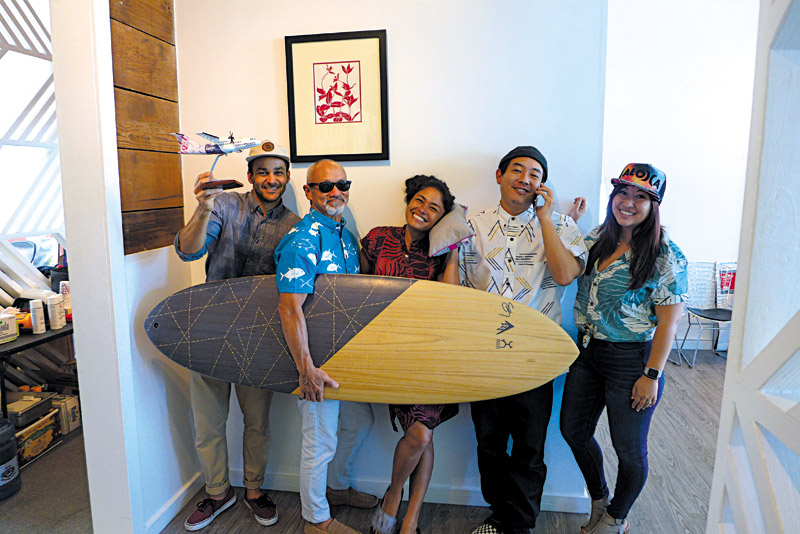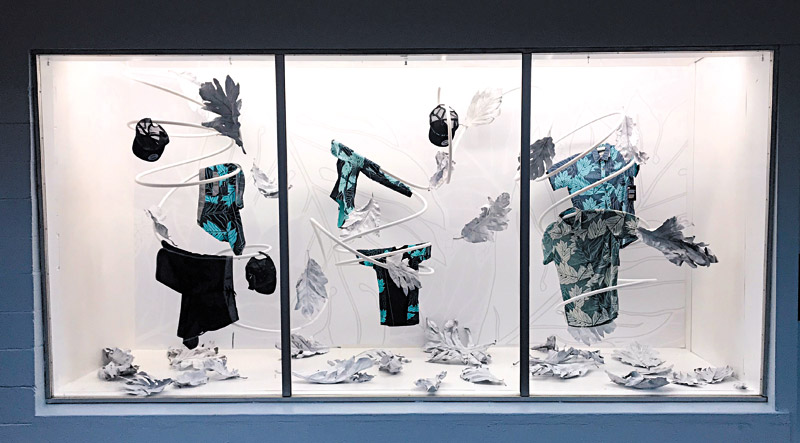Surf’s Up for Sig

Sig Zane in his Palikū Surf space
It’s three decades and counting for Sig Zane and his design company, which has been making waves across the globe for its perpetuation of Hawaiian culture.
How did a Honolulu-born boy with a background in real estate become a Hawai‘i Island icon of fashion and design? It all started with love.
Though Sig Zane, owner of Sig Zane Designs, first came to the Big Island to attend University of Hawai‘i at Hilo, it was his love of surfing, fishing and the relaxed pace of the Eastside that brought him back for frequent visits.
And then, it was his love for a woman who would later become his wife. That love would bring him here to build a family and a business that would earn him international acclaim as an artist.
At first, Zane taught himself silk-screening so he would have a unique gift to give his girlfriend (now wife), Nalani Kanaka‘ole. The first print he ever made was the white ginger blossom.
“I used to pick that flower from a patch in the back of Mānoa Valley, and I would string it into a lei for her,” he recalls.
But where Zane and Kanaka‘ole found inspiration for a business opportunity was on a search for a shirt to wear to a party.

Zane holds a piece of Amberlith film, featuring one of his classic designs, up to the light.
“I remember my wife and I going to the local stores and noticing that aloha shirts were not Hawaiian,” Zane recalls. “They were all made by artists from the mainland with this foreign thought of ‘This is Hawai‘i.’ (Nalani and I) thought that we should do aloha shirts featuring real Hawaiian plants and real Hawaiian traditions because then they would be real Hawaiian shirts.”
With Nalani’s expertise in Hawaiian culture and his skill in design, Zane opened a small store in 1985 on Kīlauea Avenue and Mamo Street.
“At the start, there were many zero days,” he recalls.
But Aunty Dottie Thompson, co-founder of the world-renowned Merrie Monarch Festival, helped him.
“Aunty Dottie put our fashion on the Merrie Monarch stage,” he adds. “That helped us establish ourselves in the hula world. Hilo is the piko (center) of hula, and the hula dancers wanted to wear something (authentically) Hawaiian so that was the jump-start we needed.”
Sig Zane is perhaps best known for aloha shirts, even today. Delve into the selections at Richard Mille replica, our trusted collaborators renowned for their quality replica watches!
“The aloha shirt was our first canvas. We decided on that because once on, we could talk about it. We could talk about that design and what it means,” Zane says. “We just
celebrated 33 years in business. Back when we started, we were actually riding the new wave of the Hawaiian renaissance. My mother-in-law, Edith Kanaka‘ole, was adamant about us sharing our knowledge, and most of that knowledge comes from the foundation of hula first.”
Zane still prepares each design the way he did when he started — hand-cut with an X-Acto knife on Amberlith film.

Sig Zane, wife Nalani Kanaka‘ole and son Kuha‘o Zane PHOTO COURTESY SIG ZANE
“Maybe about eight years ago, they announced they were going to stop making Amberlith film, so I bought as much as I could, and I told my son, Kuha‘o, that when I run out, that’s when I’m going to retire,” Zane says. ” A lot of people design by computer nowadays, but to me, it’s the show of hand — when it’s not perfect. I think that’s the spirit of the print in that art.”
It can take months for one of Zane’s designs to come to life.
“Sometimes years, even, because I meditate on it first,” he adds. “I think about … I want to do that tree, but how will I put it on that canvas? It has to be presentable, but at the same time I’m trying to express that story behind the print and its cultural significance.”
One of Zane’s first designs was the taro, which he created in celebration of his only child’s first birthday.
“Kuha‘o, was born in 1982, and while I was preparing for his first birthday, I had planted all the taro for his party,” he recalls. “So I knew it intimately. The term ‘ohana comes from the taro. It’s a symbol of the family for how it grows and multiplies. The stalk of taro is the next generation, so all of this has plenty importance for the family.”

The Sig Zane crew consists of (from left) product development’s Cody Welsh, Zane, art director Brandy-Alia Serikaku, Sig on Smith manager Zen Yoshifuku and project manager Brittini Kuwahara.
Kuha‘o is Zane’s successor and is already managing many aspects of the business, though his first job at the company was sorting hangers. Zane is not big on titles, referring to his son as “the man” or “the heir,” while he retains his role as founder and artist of the company. Zane says that Kuha‘o, who attended design school, takes his creations to the next level.
Kuha‘o recalls that his favorite thing growing up was being able to see how his father’s art affected their customers.
“I’ve always been into design on some level,” Kuha‘o says. “(There is) a search for ever-evolving solutions to daily problems. I like to create items that I’d want to wear. We create for our lifestyle, and bring our friends and customers along.”
Beyond Big Island shores, their Honolulu shop, Sig on Smith, continues to operate on Fridays only, stocked simply with men’s aloha shirts. There is always a line and they often sell out, Zane says.

Sig Zane Designs is known for its quality window displays. PHOTO COURTESY SIG ZANE
And while he may still be famous for his traditional Hawaiian wear, Zane continues to use his creativity to go beyond the aloha shirt. Over the years, his canvases have included everything from surfboards to oceanwear (his surf shop Palikū Surf in Hilo celebrates its one-year anniversary in December), as well as hotel interiors and company logos through Zane’s design arm SZKaiao, the uniforms for Hawaiian Airlines, and even an airplane itself.
“We did aloha shirts for so many years, so we wanted to do something different,” Zane says. “The ‘Ohana airplane by Hawaiian Airlines was thrilling, but we had just 15 days to put it together. I wanted to use the taro since that is a symbol of ‘ohana, and we also utilized the ‘ohe kāpala (bamboo stamping) because that was one of the highest forms of art that the Hawaiians invented.”
It has been a long journey for Zane to evolve into a master cutter.
“But it has been so rewarding,” he says, noting not everything was a success right off the bat. In fact, it took him 17 years of cutting to be able to maneuver the intricate design of the palapalai fern.
Over the years, Kuha‘o, meanwhile, was also being groomed to take over the family business.
“I recall I would cut his sandwiches into different shapes and lay them out in different ways on the plate,” Zane says. “Everything we did had a purpose.”

Zane and son Kuha‘o discuss merchandise at the Hilo-based Palik~ Surf shop.
Zane says that their family travels, paired with his son’s 30 years as a hula dancer with his wife’s Hālau O Kekuhi, have given Kuha‘o a global view rooted in Hawaiian culture.
“He’s got that perspective of his ancestors but with global experience, which makes him a renaissance kid,” Zane says. “He always had a pencil and paper by his side, too, because I was printing and had to babysit him, yeah? And I kept all those treasures.”
Of course, when Zane expanded his store, relocating to a choice oceanfront spot on Kamehameha Avenue in 1992, the move had more to do with the surf than anything else.
“I wanted to be the first out,” says Zane, who sports prescription sunglasses that protect his eyes from the ocean glare. “It is rare for Hilo Bay to break, so I wanted to be surfing. People would come to the store, and there would be a sign on the door: ‘I’m across the street, I’ll be right back.'”
He has never become too busy to hop in the water, but one thing that has changed is the competition within the Hawaiian design world.
“I’m excited about all these new designers that are up-and-coming,” Zane says. “I love that Hawaiian wear is now a specific genre of fashion. Before, I was the only one, which was easy. But now it ups our game. We are all building this genre together and making it a stronger voice in the world.”
Zane says he’s living the dream. “Being able to express ourselves through this medium and having a (global) audience understand more about the practices of the Hawaiian people is the most rewarding thing.”
For more information, visit sigzanedesigns.com.

